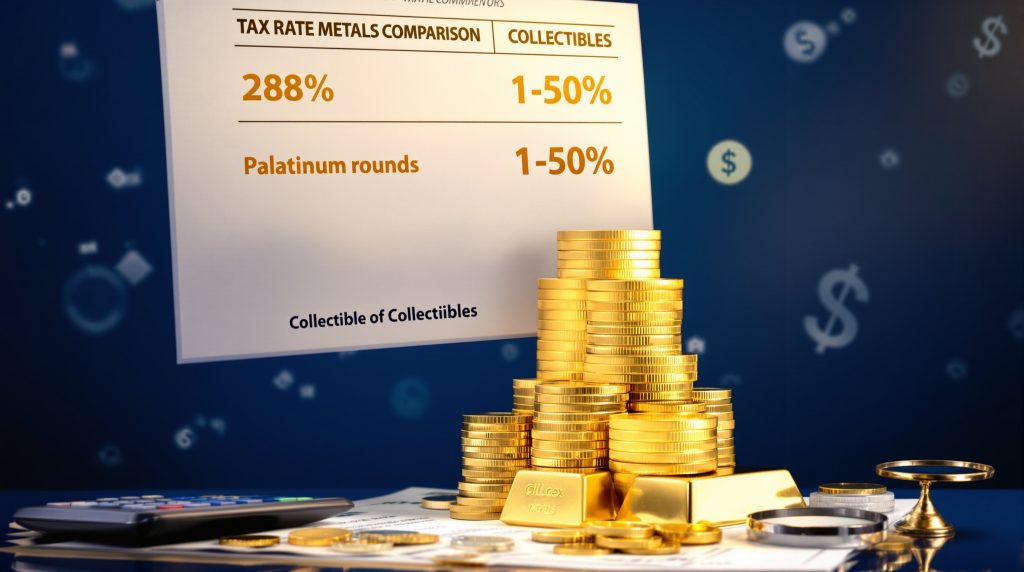Understanding the Tax Treatment of Precious Metals: A Comprehensive Guide
While most investors understand how stocks, bonds, and real estate are taxed, precious metals taxation often remains a mystery. This guide breaks down the unique tax considerations for gold, silver, platinum, and palladium investments, helping you make informed decisions for your portfolio.
How Are Precious Metals Classified for Tax Purposes?
The Collectibles Classification Paradox
The Internal Revenue Service (IRS) classifies precious metals as “collectibles” under Internal Revenue Code Section 408(m), regardless of their form or purpose. This classification applies to standard bullion products like American Gold Eagles and Krugerrands, even though they lack any numismatic or collectible value.
This tax treatment stands in stark contrast to other investment assets like stocks and bonds, which benefit from more favorable capital gains rates. The collectibles designation dates back to earlier tax code provisions and has persisted despite the growing recognition of precious metals as legitimate investment opportunities rather than mere collectibles.
Historical tax legislation grouped precious metals with art, antiques, and stamps—items typically purchased for appreciation rather than practical use or income generation. This classification hasn’t evolved despite the modern investment case for precious metals as portfolio diversification tools and inflation hedges.
Impact on Investment Strategy
The collectibles classification significantly impacts long-term investment planning. Unlike standard securities that benefit from preferential long-term capital gains rates of 15-20%, precious metals face a maximum tax rate of 28% when held longer than one year.
This tax disparity creates planning challenges for investors seeking to optimize their after-tax returns. Many investors must weigh the portfolio diversification benefits of precious metals against their less favorable tax treatment.
| Investment Type | Short-Term Tax Rate (< 1 year) | Long-Term Tax Rate (> 1 year) |
|---|---|---|
| Precious Metals | 10-37% (Ordinary Income) | Up to 28% (Collectibles Rate) |
| Stocks/ETFs | 10-37% (Ordinary Income) | 0%, 15%, or 20% (Based on Income) |
| Real Estate | 10-37% (Ordinary Income) | 0%, 15%, or 20% (Based on Income) |
This classification has led many sophisticated investors to seek alternative methods of precious metals exposure that might qualify for standard capital gains treatment, such as mining stocks or certain ETFs.
What Tax Rates Apply to Precious Metals Transactions?
Long-Term Capital Gains Treatment
Precious metals held for more than one year are subject to the “collectibles” tax rate, which is capped at 28% under IRC Section 1(h)(4). This contrasts sharply with the standard long-term capital gains rates of 0%, 15%, or 20% that apply to most other investments based on income level.
The 28% rate applies only to the extent that your taxable income exceeds the threshold for the 25% ordinary income tax bracket. If your income falls below this threshold, your long-term capital gains from precious metals would be taxed at your ordinary income tax rate.
Example calculation:
- Purchase: 10 ounces of gold at $1,300 per ounce ($13,000 total)
- Sale: 10 ounces of gold at $1,800 per ounce ($18,000 total) after holding for 18 months
- Capital gain: $5,000
- Tax due (assuming highest bracket): $1,400 ($5,000 × 28%)
This higher tax burden creates a significant disadvantage for precious metals compared to other long-term investments.
Short-Term Capital Gains Implications
For precious metals held less than one year, gains are taxed as ordinary income, with rates ranging from 10% to 37% based on your tax bracket. This matches the short-term capital gains treatment of other investments.
The timing of your sale can dramatically impact your tax liability. Consider this comparison:
| Holding Period | Sale Price | Original Cost | Gain | Tax Rate | Tax Due |
|---|---|---|---|---|---|
| 11 months | $18,000 | $13,000 | $5,000 | 37% (highest bracket) | $1,850 |
| 13 months | $18,000 | $13,000 | $5,000 | 28% (collectibles rate) | $1,400 |
This example illustrates why some investors carefully time their sales to optimize tax treatment, especially when close to the one-year holding threshold.
Additional Tax Considerations
High-income earners face an additional 3.8% Net Investment Income Tax (NIIT) on investment income, including precious metals gains, when their modified adjusted gross income exceeds $200,000 (single filers) or $250,000 (married filing jointly).
State taxation adds another layer of complexity. Some states follow federal treatment of precious metals, while others have enacted specific exemptions. For example, Arizona and Utah have passed legislation exempting certain precious metals transactions from state capital gains taxes.
Unlike securities, precious metals are not subject to the “wash sale rule,” which prevents investors from claiming tax losses when repurchasing substantially identical securities within 30 days. This creates potential tax-loss harvesting opportunities not available with stocks.
How Is Income from Precious Metals Taxed?
Yield and Interest Income Taxation
When you receive income or yield paid in physical precious metals, the IRS treats this as ordinary income taxable in the year received. The income amount is calculated based on the dollar-equivalent value of the metal on the date of receipt.
For example, if you receive one ounce of gold as a yield payment when gold is trading at $3,300 per ounce, you must report $3,300 of ordinary income on your tax return for that year—even if you don’t sell the gold.
This income is typically reported on Schedule B (for interest income) or Schedule C (for business income) of your federal tax return. The payer should provide you with appropriate tax documentation, such as Form 1099-INT or Form 1099-MISC, showing the dollar value of the metal received.
Cost Basis Determination
The dollar value of precious metals received as income establishes your cost basis for future capital gains calculations. Using our previous example, the $3,300 value of your one-ounce gold yield payment becomes your cost basis for that ounce.
If you later sell that ounce for $3,500, you would calculate a $200 capital gain ($3,500 sale price minus $3,300 cost basis). This gain would then be subject to either short-term or long-term capital gains treatment depending on your holding period.
Tracking cost basis becomes more complex with multiple purchases or income payments over time. Consider using accounting methods such as First In, First Out (FIFO) or specific identification to optimize your tax treatment when selling portions of your holdings.
Practical Example of Yield Taxation
Let’s walk through a comprehensive example of how yield taxation works:
- You invest in a gold-yielding product that pays a 3% annual return in physical gold
- Your initial investment is 10 ounces (worth $33,000 at $3,300/oz)
- After one year, you receive 0.3 ounces as yield (3% of 10 ounces)
- On the day of receipt, gold is trading at $3,300/oz
Tax implications:
- Income to report: $990 ($3,300 × 0.3 oz)
- This is taxed as ordinary income in the year received
- Your cost basis in the 0.3 ounces is $990
- If gold rises to $3,500/oz and you sell, you’ll have a $60 capital gain ($3,500 × 0.3 = $1,050 – $990 = $60)
This example illustrates why proper documentation of both receipt dates and metal values is essential for accurate tax reporting.
What Are the Tax Implications of Different Ownership Methods?
Direct Physical Ownership
Direct ownership of physical precious metals—whether stored at home, in a bank safe deposit box, or in a private vault—subjects you to the standard collectibles tax treatment discussed earlier. Your capital gains will face the 28% maximum long-term rate or ordinary income rates for short-term holdings.
Storage location generally doesn’t affect federal tax treatment, but may have implications for state taxation or reporting requirements. Storage costs, including vault fees and insurance premiums, are typically not tax-deductible for personally held metals.
For estate planning purposes, physical precious metals receive a stepped-up basis at death, meaning heirs inherit the metals at their fair market value on the date of death rather than the original purchase price. This can eliminate capital gains tax on appreciation that occurred during the deceased’s lifetime.
Precious Metals IRAs
Self-directed Individual Retirement Accounts (IRAs) can hold certain IRS-approved precious metals, providing potential tax advantages:
- Traditional IRA: Tax-deferred growth with taxes paid upon withdrawal at ordinary income rates
- Roth IRA: Tax-free growth and tax-free qualified withdrawals
While these accounts can shield you from year-to-year capital gains taxation, there are important limitations:
- Only certain forms of precious metals are permitted (specific coins and bars meeting minimum fineness requirements)
- The metals must be held by an approved custodian, not personally
- Annual contribution limits apply ($7,000 for 2024, $8,000 for those 50+)
- Required Minimum Distributions (RMDs) beginning at age 73 may necessitate liquidating some metals
The prohibited transaction rules are particularly strict for precious metals IRAs. Self-dealing, including storing IRA-owned metals in your home, can disqualify the entire IRA and trigger significant tax consequences.
ETFs and Mining Stocks
Exchange-traded funds (ETFs) that track precious metals prices and mining company stocks provide alternative exposure methods with potentially different tax treatment:
- Physically-backed ETFs: Most precious metals ETFs structured as grantor trusts (like SPDR Gold Shares, ticker GLD) are still taxed as collectibles, subject to the 28% maximum rate
- Futures-based ETFs: ETFs using futures contracts may qualify for “60/40” tax treatment (60% long-term, 40% short-term gains regardless of holding period)
- Mining stocks: Shares in mining companies are taxed as securities with standard capital gains rates (0%, 15%, or 20% for long-term holdings)
- Mining ETFs: Funds holding mining company shares receive standard securities tax treatment
These alternatives offer greater liquidity and potentially more favorable tax treatment, though they may not provide the same direct exposure to metal prices or the security of physical ownership.
How Do International Tax Considerations Affect Precious Metals Investors?
Cross-Border Ownership Implications
International precious metals investors face additional reporting requirements and potential tax complications. U.S. taxpayers with foreign financial accounts exceeding $10,000 must file a Foreign Bank Account Report (FBAR) using FinCEN Form 114. Foreign-stored precious metals may or may not trigger FBAR requirements depending on whether they’re held in a financial account or stored directly.
The Foreign Account Tax Compliance Act (FATCA) imposes additional reporting requirements via Form 8938 for specified foreign financial assets exceeding certain thresholds. These thresholds vary based on filing status and residence:
| Filing Status | Living in U.S. | Living Abroad |
|---|---|---|
| Single/MFS | $50,000 at year-end or $75,000 any time during year | $200,000 at year-end or $300,000 any time during year |
| Married Filing Jointly | $100,000 at year-end or $150,000 any time during year | $400,000 at year-end or $600,000 any time during year |
Foreign tax credits or deductions may help offset double taxation when metals are taxed in multiple jurisdictions, though this depends on applicable tax treaties and local laws.
Change of Use Determinations
Transferring precious metals between vaults or custodians generally doesn’t create a taxable event as long as beneficial ownership remains unchanged. However, converting metals from passive holdings to productive assets (such as leasing or lending them for yield) may trigger what tax authorities call a “change of use.”
This change of use could be considered a disposition for tax purposes, potentially triggering capital gains recognition based on the difference between your cost basis and the market value on the date of conversion.
Documentation becomes particularly important in these scenarios. Maintaining detailed records of all transfers, including confirmation that beneficial ownership remained unchanged, can help substantiate your tax position if questioned by authorities.
Tax-Advantaged Jurisdictions
Several countries offer favorable tax treatment for precious metals:
- Singapore: No capital gains tax and no sales tax on investment-grade precious metals
- Switzerland: No VAT on investment gold and no capital gains tax for private investors
- United Arab Emirates: No income tax or capital gains tax, with gold transactions generally VAT-exempt
- Australia: GST-free status for investment-grade gold, though capital gains taxes apply
These jurisdictions have become popular for international metals storage, though investors must still comply with their home country’s reporting requirements and tax obligations. Cross-border transactions may trigger import duties, VAT/GST, or other taxes depending on the specific countries involved.
How Can Investors Optimize Their Precious Metals Tax Strategy?
Tax-Efficient Acquisition Methods
Strategic timing of purchases and sales can significantly impact your tax liability. Considering the spread between ordinary income rates and the collectibles rate, holding positions just beyond the one-year mark often makes sense from a tax perspective.
Dollar-cost averaging—investing fixed amounts at regular intervals—can simplify cost basis tracking while potentially reducing the impact of market volatility. However, this approach results in multiple lots with different purchase dates and prices, requiring careful record-keeping.
Product selection also impacts tax efficiency. Higher-premium products like limited-edition coins may offer collectibility upside but complicate valuation for tax purposes. Standard bullion products with minimal premiums generally provide more straightforward tax treatment.
Alternative Ownership Structures
Certain ownership structures may offer tax advantages for precious metals investors:
- Limited Liability Companies (LLCs): Can provide liability protection and potential business deductions for storage and insurance
- Family Limited Partnerships: May facilitate wealth transfer with potential gift and estate tax benefits
- Trusts: Various trust structures can support estate planning goals while maintaining control over precious metals assets
Business ownership of precious metals may allow for deduction of certain expenses that wouldn’t be deductible for personal holdings. However, the metals must serve a legitimate business purpose to qualify for these deductions.
Yield-Generating Strategies
Some investors pursue yield-generating strategies rather than selling their metals, allowing them to earn income while maintaining their position. These strategies include:
- Precious metals leasing: Lending physical metals to industrial users for a fee
- Secured lending: Using metals as collateral for loans, potentially avoiding immediate capital gains
- Streaming/royalty arrangements: More complex structures typically used by larger investors
These approaches may offer tax advantages by generating ordinary income rather than triggering capital gains. However, they introduce counterparty risk and may themselves trigger taxable events depending on how they’re structured.
A careful cost-benefit analysis should weigh potential yield against tax implications and risk factors. Documentation requirements also become more complex with these arrangements, necessitating thorough record-keeping.
What Documentation Is Required for Precious Metals Tax Reporting?
Record-Keeping Best Practices
Maintaining comprehensive documentation is essential for precious metals investors. At minimum, you should preserve:
- Purchase records: Original receipts showing date, quantity, metal type, fineness, and total cost including premiums and fees
- Sales records: Confirmation of sale price, date, and quantities sold
- Income receipts: Documentation of any yield or interest received in metal, including valuation at time of receipt
- Transfer records: Evidence of transfers between storage locations or ownership structures
- Valuation documentation: Third-party spot price verification for dates of significant transactions
Both physical and digital record-keeping systems have advantages. Physical records provide tangible evidence but risk damage or loss; digital systems offer redundancy and searchability but require security measures.
The IRS statute of limitations for audits is generally three years from the filing date, but extends to six years if you’ve omitted more than 25% of your gross income. For this reason, maintaining records for at least seven years is advisable.
Tax Form Requirements
Precious metals transactions require specific tax forms depending on the transaction type:
- Form 8949 (Sales and Other Dispositions of Capital Assets): Lists each sale or disposition of precious metals, including date acquired, date sold, proceeds, cost basis, and gain/loss
- Schedule D (Capital Gains and Losses): Summarizes the information from Form 8949
- Schedule B (Interest and Ordinary Dividends): Reports interest or dividends received in precious metals
- Form 1040 Schedule C: Used if metals are held as part of a business
- FinCEN Form 114 (FBAR): Required for foreign financial accounts exceeding $10,000
- Form 8938 (Statement of Specified Foreign Financial Assets): For foreign assets exceeding certain thresholds
Dealers are required to file Form 1099-B for certain precious metals transactions exceeding specific thresholds, though reporting requirements vary by metal type and transaction size. Private transactions between individuals generally don’t trigger 1099 reporting requirements.
Audit Preparation Strategies
In the event of an IRS audit, having organized documentation is your best defense. Create a hierarchical system that allows you to quickly produce:
- Summary of all precious metals transactions by year
- Detailed transaction records with supporting documentation
- Third-party verification of metal values on relevant dates
- Chain of custody documentation for metals stored or transferred internationally
For complex situations involving international holdings, alternative ownership structures, or large transactions, professional assistance from accountants and tax attorneys familiar with precious metals taxation is highly recommended.
How Do Recent Tax Law Changes Affect Precious Metals Investors?
Current Legislative Environment
The tax treatment of precious metals has remained relatively stable in recent years, with the 28% collectibles rate unchanged since the Tax Reform Act of 1986. However, broader tax reforms can indirectly impact precious metals investors.
The Tax Cuts and Jobs Act of 2017 eliminated the opportunity to use like-kind exchanges (Section 1031) for precious metals, which previously allowed investors to defer capital gains by exchanging one type of metal for another. Now, like-kind exchanges are limited to real estate.
Recent IRS guidance has clarified reporting requirements for precious metals dealers and investors, particularly regarding information reporting thresholds. These clarifications have generally maintained the status quo rather than introducing new tax burdens.
Inflation Reduction Act Implications
The Inflation Reduction Act of 2022 includes provisions that could indirectly affect precious metals markets:
- Increased IRS funding may lead to enhanced enforcement of existing tax laws, potentially increasing audit risk for precious metals investors
- Climate and energy provisions may impact mining operations and supply chains for precious metals
- Corporate minimum tax provisions could affect mining company profitability and stock performance
While the Act doesn’t directly change precious metals taxation, these indirect effects may influence market dynamics and investment returns. Investors should monitor implementation details and enforcement priorities as they evolve.
State-level developments show more variation, with several states enacting or considering legislation to exempt precious metals from sales taxes or state-level capital gains taxes. These state initiatives reflect growing recognition of precious metals as monetary assets rather than mere collectibles.
What Are Common Tax Pitfalls for Precious Metals Investors?
Reporting Errors and Omissions
Common reporting mistakes include:
- Failure to report income received in metal: Many investors incorrectly assume that income paid “in kind” isn’t taxable until sold
- Incorrect basis calculation: Failing to include acquisition costs such as premiums, shipping, and insurance in your cost basis
- Improper lot identification: Not specifying which metals were sold when disposing of a partial position
- Missing foreign account reporting: Overlooking FBAR or FATCA requirements for internationally stored metals
These errors can result in substantial penalties. The IRS typically charges 20% for accuracy-related penalties, plus interest on unpaid taxes. For intentional disregard of reporting requirements, penalties can reach 75% of the understated tax.
If you discover past reporting errors, voluntary disclosure through amended returns generally results in more favorable treatment than waiting for IRS discovery during an audit.
Valuation Challenges
Determining fair market value can be challenging, particularly for:
- Numismatic or semi-numismatic items: Coins with collector value beyond their metal content
- Unusual items: Non-standard weights, purities, or manufacturers
- Bulk transactions: Large quantity purchases or sales that might deviate from spot prices
When facing valuation challenges, consider:
- Obtaining multiple dealer quotes dated on the transaction date
- Referencing published spot prices from major exchanges
- Documenting any premiums or discounts and their justification
- Consulting with professional appraisers for significant or unusual items
Be particularly careful with related-party transactions, as the IRS scrutinizes these for potential undervaluation or overvaluation to manipulate tax outcomes.
FAQ: Critical Tax Questions for Precious Metals Investors
Is transferring metals between vaults a taxable event?
In most cases, transferring metals between storage facilities does not trigger a taxable event, provided beneficial ownership remains unchanged. The key is whether you maintain ownership rights throughout the transfer process.
Documentation is crucial in these scenarios. Obtain written confirmation from both the sending and receiving custodians that the transfer represents a change in location, not ownership. This documentation should clearly identify the specific metals being transferred to maintain chain of custody.
Some jurisdictions may have different interpretations, particularly for international transfers, so consulting with a tax professional familiar with both countries’ laws is advisable.
How are precious metals in retirement accounts taxed?
Precious metals held in qualified retirement accounts (IRAs, 401(k)s) receive tax treatment based on the account type, not the underlying asset:
- Traditional retirement accounts: Contributions may be tax-deductible, growth is tax-deferred, and distributions are taxed as ordinary income
- Roth accounts: Contributions are made with after-tax dollars, but qualified distributions (including gains) are tax-free
The collectibles tax rate doesn’t apply within these accounts. However, when taking distributions, the entire distribution amount from traditional accounts is taxed as ordinary income regardless of how much represents capital gains.
RMDs present a particular challenge for precious metals IRAs. Since physical metals can’t be distributed in fractional amounts, you might need to liquidate entire coins or bars to satisfy RMD requirements, potentially forcing sales during unfavorable market conditions.
What are the tax implications of converting metals to cryptocurrency?
Converting precious metals to cryptocurrency is treated as two separate transactions:
- A sale of precious metals, potentially triggering capital gains tax based on your cost basis
- A purchase of cryptocurrency establishing a new cost basis for the crypto assets
Prior to 2018, some argued these conversions might qualify as like-kind exchanges under Section 1031. However, the Tax Cuts and Jobs Act explicitly limited like-kind exchange treatment to real property, eliminating this possibility for precious metals or cryptocurrency transactions.
When converting metals to crypto, document the fair market value of both assets at the exact time of conversion. This value serves as both the amount realized on your metals sale and your new cost basis in the cryptocurrency.
Strategic Tax Planning for Precious Metals Investors
Balancing Tax Efficiency with Investment Goals
Effective precious metals investment requires balancing tax considerations with your broader investment objectives. While minimizing taxes is important, it shouldn’t override fundamental investment principles or your portfolio diversification needs.
Consider these strategic approaches:
- Hold for appropriate timeframes: Aligning holding periods with tax thresholds (particularly the one-year mark) can optimize tax treatment
- Diversify ownership methods: Combining physical metals, ETFs, mining stocks, and retirement account holdings can provide both direct exposure and tax diversification
- Harvest losses strategically: Unlike securities, precious metals aren’t subject to wash sale rules, creating unique tax-loss harvesting opportunities
- Consider yield-generating options: Earning income on metals may provide better after-tax returns than buying and selling for capital gains
These strategies should align with your risk tolerance, investment horizon, and overall portfolio strategy. Precious metals typically serve as a portfolio diversifier and inflation hedge rather than a primary growth vehicle.
Future-Proofing Your Precious Metals Tax Strategy
Tax laws evolve over time, requiring investors to maintain flexibility in their approach. To future-proof your precious metals tax strategy:
- Stay informed about legislative changes: Monitor both federal and state-level developments that could impact precious metals taxation
- Maintain meticulous records: Comprehensive documentation provides options regardless of future tax law changes
- Review ownership structures periodically: Ensure your chosen method remains optimal as tax laws and personal circumstances change
- Consider international diversification: Strategically positioned holdings across jurisdictions may provide protection against country-specific tax changes
Working with tax professionals who specialize in alternative investments can provide valuable guidance as you navigate this complex landscape. Their expertise can help you adapt to changing tax environments while maintaining compliance with existing regulations.
By understanding the unique tax treatment of precious metals and implementing thoughtful strategies, investors can maximize their after-tax returns while benefiting from the portfolio diversification and wealth preservation benefits these assets provide. Recent market analysis suggests undervalued gold stocks may present additional opportunities, particularly with favorable gold price forecast trends and potential lithium tax breaks in certain jurisdictions. However, investors should remain vigilant about potential issues like VAT refund suspension that can impact mining operations in various regions.
Want to Stay Ahead of Market-Moving Mineral Discoveries?
Don’t miss another major discovery announcement on the ASX. Gain instant alerts on significant mineral discoveries through Discovery Alert’s proprietary Discovery IQ model, giving you the edge to capitalise on potential opportunities before the broader market. Explore historic returns of major mineral discoveries at https://discoveryalert.com.au/discoveries/ and position yourself for success.




